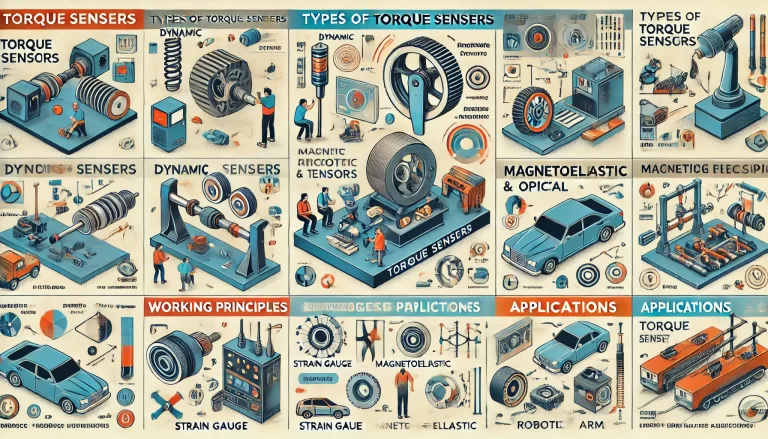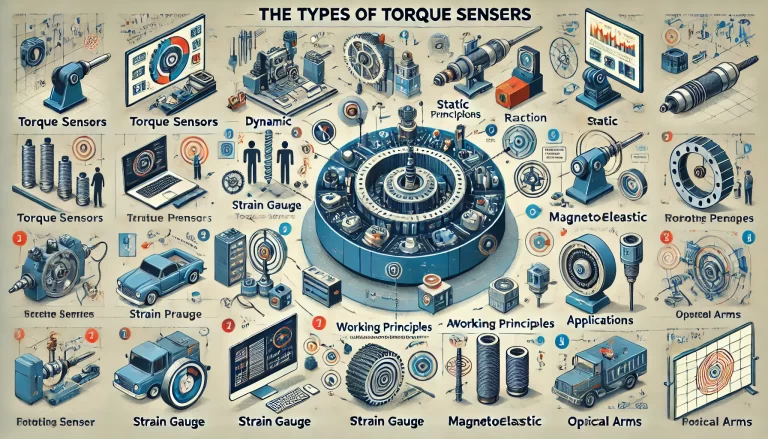1. Introduction
A torque sensor, also known as a torque transducer, torque meter, or torque gauge, is an essential instrument used to measure the torque or rotational force applied to various mechanical components. Torque sensors play a crucial role in evaluating the performance of rotating and non-rotating parts by converting mechanical torque into precise electrical signals. These sensors are widely utilized in industries such as automotive, aerospace, manufacturing, and research laboratories.
Torque sensors can be broadly classified into two major categories: dynamic (rotary) torque sensors and static (reaction) torque sensors. Each type serves specific applications and employs distinct operating principles.
2. Classification of Torque Sensors
Dynamic (Rotary) Torque Sensors:
Also referred to as rotational torque sensors, rotary torque transducers, or non-contact torque sensors.
Designed to measure torque in rotating components such as motors, engines, and gearboxes.
Typically use strain gauges or magnetic coupling to transmit data without physical contact.
Suitable for applications requiring real-time torque monitoring.
Static (Reaction) Torque Sensors:
Measure torque in stationary components where rotation does not occur.
Often used for testing materials and assemblies where applied torque is analyzed under static conditions.
Characterized by their high precision and reliability.

3. Working Principles of Torque Sensors
Torque sensors operate by detecting the strain or deformation experienced by a mechanical component when subjected to torque forces. The primary working principles include:
Strain Gauge Technology:
Most commonly used in torque sensors.
Consists of strain-sensitive resistors attached to a rotating shaft, which experience deformation proportional to the applied torque.
Changes in electrical resistance are converted into an electrical signal that represents torque values.
Magnetoelastic Technology:
Utilizes the magnetoelastic properties of materials, where magnetic permeability changes under mechanical stress.
Offers high sensitivity and can be used in harsh environments.
Optical Technology:
Uses laser-based or fiber optic systems to measure angular displacement and torque.
Provides high accuracy with minimal signal interference.
4. Key Features and Advantages
Torque sensors offer several benefits that make them essential across various applications:
High Accuracy: Provides precise torque measurements crucial for quality control and process optimization.
Fast Response Time: Ensures real-time monitoring and control of mechanical systems.
Durability and Longevity: Built to withstand harsh operational environments with minimal maintenance.
Versatility: Can be used across a wide range of industrial and research applications.
5. Applications of Torque Sensors
Torque sensors have a diverse range of applications across various industries, including but not limited to:
Automotive Industry:
Measurement of engine and drivetrain performance.
Evaluation of torque output in electric and hybrid vehicles.
Testing of components such as power steering systems and braking mechanisms.
Aerospace Sector:
Performance analysis of aircraft engines and turbines.
Monitoring of torque levels in control surfaces and landing gear mechanisms.
Manufacturing and Industrial Machinery:
Monitoring of torque in conveyor systems, gearboxes, and robotic arms.
Ensuring optimal torque levels in assembly processes.
Energy and Power Generation:
Performance assessment of wind turbines and hydroelectric generators.
Monitoring torque output in power transmission systems.
Medical Equipment:
Used in prosthetics and robotic surgical instruments to ensure precise force control.
Laboratory and Research Applications:
Development of viscosity measurement devices (e.g., viscometers).
Quality control testing in R&D departments.
Process and Chemical Industries:
Monitoring torque in pumps, compressors, and mixing equipment.
Ensuring consistent material processing in pharmaceutical and food industries.

6. Factors to Consider When Choosing a Torque Sensor
When selecting a torque sensor for a specific application, several factors must be taken into account:
Measurement Range: Ensure the sensor can handle the expected torque loads.
Accuracy and Resolution: Choose sensors with precision levels appropriate for the application.
Environmental Conditions: Consider temperature, humidity, and potential exposure to chemicals.
Output Signal Type: Analog or digital outputs depending on integration requirements.
Mounting and Installation Requirements: Evaluate ease of installation and compatibility with existing systems.
7. Conclusion
Torque sensors are indispensable tools for measuring and monitoring torque across a wide range of industries. Understanding the types, working principles, and applications of torque sensors helps in selecting the right device to achieve optimal performance and efficiency. As technology continues to evolve, advancements in sensor design and data processing capabilities will further enhance their precision, reliability, and usability in various industrial applications.
